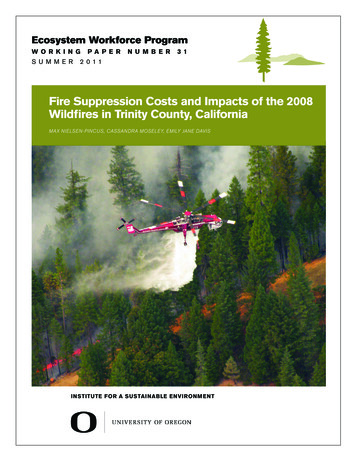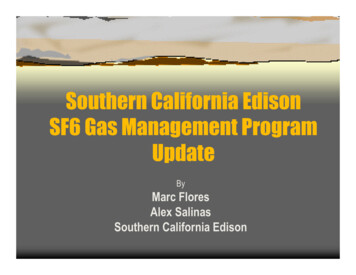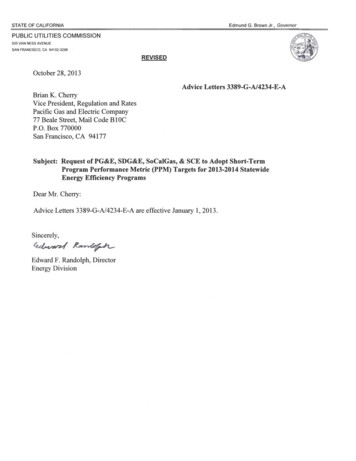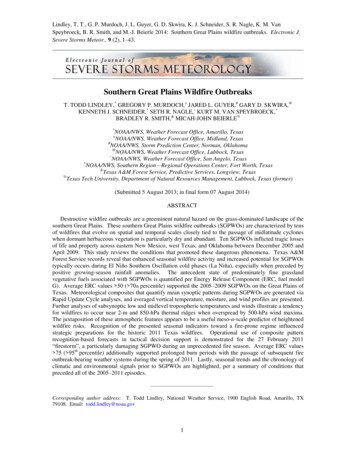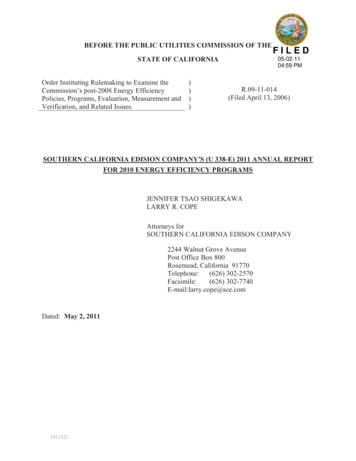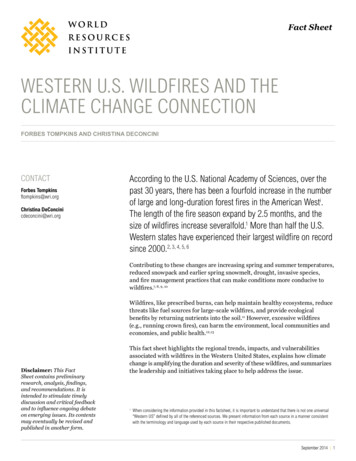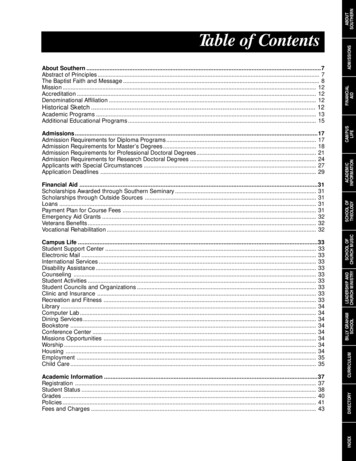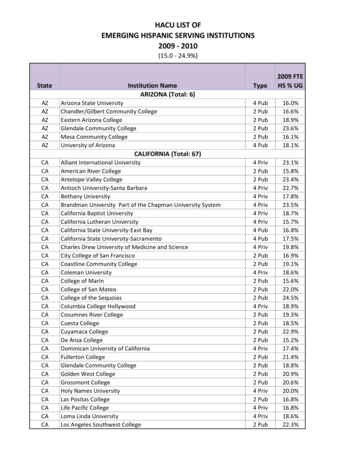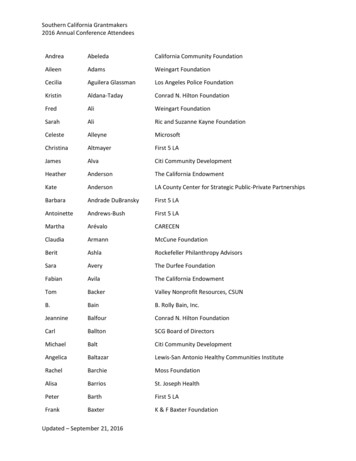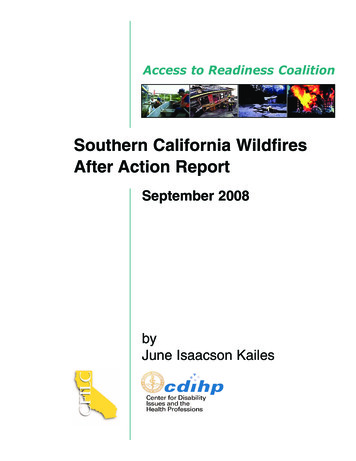
Transcription
Access to Readiness CoalitionSouthern California WildfiresAfter Action ReportSeptember 2008byJune Isaacson Kailes
Required citation:Kailes, J. 2008. Southern California Wildfires AfterAction Report, prepared in partnership with theAccess to Readiness Coalition, The CaliforniaFoundation for Independent Living Centers, and TheCenter for Disability Issues and the HealthProfessions at Western University of Health Sciences.Permission is granted to copy and distribute thismaterial provided that:1. Proper copyright notice and citation (above) isattached to each copy;2. No alterations are made to the contents of thedocument;3. The document is not sold for profit; and4. The Center for Disability Issues and the HealthProfessions or the Access to Readiness Coalitonis notified of such use. Please contactjik@pacbell.net or go towww.access2readiness.org for contactinformation.Southern California Wildfires After Action ReportBy June Isaacson Kailes, Associate DirectorCenter for Disability Issues and the HealthProfessions at Western University of HealthSciences, Pomona, CaliforniaPhone 310-821-7080 Fax 310-827-0269jik@pacbell.netwww.cdihp.orgThis report is available at www.access2readiness.orgor www.jik.com/disaster.htmlSouthern California Wildfires After Action Report2
AcknowledgementsThis report was made possible, in part throughgenerous support from: Administration on Developmental Disabilities California Consumer Protection Foundation’sCommunity Collaborative Fund California Department of Public Health, Office onDisability and Health Pacific Gas and Electric CompanyThe opinions expressed are those of the authorand the California Foundation of Independent LivingCenters (CFILC). They do not necessarily representthose of the funders.Individuals chosen for their diverse perspectivesand technical expertise reviewed this report in draftform. The author thanks these individuals for theircandid and critical comments that assisted inmaking this report as accurate as possible. Stephanie A. Biedermann, Arthur LimanFellowship Attorney, Disability Rights Advocates,Berkeley Sarah W. Blackstone, President, AugmentativeCommunication Inc., Monterey Phyllis Dinse, Coalition Organizer, CaliforniaFoundation for Independent Living Centers,Sacramento Alexandra Enders, Senior Research Associate /Policy Analyst, Rural Institute on Disabilities,Southern California Wildfires After Action Report3
University of Montana, Missoula, MT Judy Harkins, Gallaudet University, Washington,DC Teresa Favuzzi, Executive Director, CaliforniaFoundation for Independent Living Centers,Sacramento Debbie Fulmer, Department of HomelandSecurity, Office for Civil Rights and CivilLiberties, Washington, DC Brenda Premo, Center for Disability Issues andthe Health Professions at Western University ofHealth Sciences, Pomona Richard Ray, Department on Disability, DisabilityAccess and Services, Los Angeles Bill Vogel, Chief of the Management and StaffService Branch, California Department of SocialServices, SacramentoPhotographers: Leon Stevens, June Kailes, RobertKailesDesigned by: Kay Pegram, KaymarCommunications, kaypegram@aol.comPrinted by: Sierra Office Supply & Printing,www.sierrabg.comSouthern California Wildfires After Action Report4
DedicationThis report is dedicated to the many peoplewith disabilities and activity limitations wholost their independence or their lives becauseinformation transfer and the lessons learnedand documented over the last 30 years, arenot yet uniformly applied.Southern California Wildfires After Action Report5
Table of ContentsAcknowledgments . . . . . . . . . . . . . . . . . . . . . . . . .3Dedication . . . . . . . . . . . . . . . . . . . . . . . . . . . . . . . .51.Executive Summary . . . . . . . . . . . . . . . . . . . . .92.Definition and Acronyms . . . . . . . . . . . . . . . .133.Introduction . . . . . . . . . . . . . . . . . . . . . . . . . .243.1 Purpose . . . . . . . . . . . . . . . . . . . . . . . . .243.2 The Event . . . . . . . . . . . . . . . . . . . . . . . .253.3 Methods . . . . . . . . . . . . . . . . . . . . . . . . .264.Cross Cutting Issues . . . . . . . . . . . . . . . . . . .284.1. Narrow Definitions of DisabilityDo Not Work In Disaster Planningand Response . . . . . . . . . . . . . . . . . . . .284.2. Moving Emergency Planningfrom “Special Needs” to“Functional Needs” . . . . . . . . . . . . . . . .324.3. Grants and Funding . . . . . . . . . . . . . . . .404.4. Emergency Registries . . . . . . . . . . . . . .435.Communication Access. . . . . . . . . . . . . . . .475.1. People Who are Deaf, Deaf-Blind,and Hard of Hearing . . . . . . . . . . . . . . . .485.2. Mass Notification Systemsfor Evacuation . . . . . . . . . . . . . . . . . . . . .505.3. TV Broadcast . . . . . . . . . . . . . . . . . . . . .515.4. Emergency Warning Systems . . . . . . . .54Southern California Wildfires After Action Report6
5.5. Public Safety Answering Points(PSAPs) . . . . . . . . . . . . . . . . . . . . . . . . . . . . .59"I got a phone callfrom a woman whowas using a powerchair who was givenliterally seconds to getevacuated out of herhome. The policemancame . . . telling herto get out. There wasno way for her to getout, no transportation.They grabbed aneighbor, picked herup, put her in theback of a car and tookher to the high school.When she got to thehigh school she wasleft in the back seat(of the car), nobodywanted to beresponsible."5.6. Communication Access at Sheltersand Assistance . . . . . . . . . . . . . . . . . . . .626.Mass Care and Shelter . . . . . . . . . . . . . . . . .686.1. ADA Requirements . . . . . . . . . . . . . . . .696.2. Medications, Durable Medical Equipmentand Consumable Medical Supplies . . . .726.3. Health Advisories . . . . . . . . . . . . . . . . . .756.4. Compensate In-Home SupportiveServices Homecare Workersfor Services . . . . . . . . . . . . . . . . . . . . . .766.5. Functional Assessment and ServiceTeams Evacuation and Transportation . .777.Evacuation and Transportation . . . . . . . . . . .858.Nongovernmental Organizations Role ofProvider and Advocacy Organizations inDisaster Response . . . . . . . . . . . . . . . . . . . .908.1. Disability Emergency Briefing Team . . . .928.2. Priority Emergency Client Contact List . .958.3. Timeliness of Hot Washes . . . . . . . . . . .968.4. Mitigation Assistance Programs . . . . . . .979.Long Term Care Facilities . . . . . . . . . . . . . . .9910. Training and Exercise Programs . . . . . . . .10110.1. Exercises . . . . . . . . . . . . . . . . . . . . . .10510.2. Individual and Family EmergencyPreparedness Trainingand Materials . . . . . . . . . . . . . . . . . . .107Southern California Wildfires After Action Report7
11. Summary of Recommendations . . . . . . . . .11012. About the Sponsors and the Author . . . . . .13512.1. The California Foundation forIndependent Living Centers . . . . . . . .13512.2 Center for Disability Issues andthe Health Professions . . . . . . . . . . . .13512.3. The Author . . . . . . . . . . . . . . . . . . . . .13613. References . . . . . . . . . . . . . . . . . . . . . . . . .13814. Attachments . . . . . . . . . . . . . . . . . . . . . . . . .14414.1. Key Informants . . . . . . . . . . . . . . . . .14414.2. Sample: Emergency Notification:Register Your Cell Phone andE-Mail Address . . . . . . . . . . . . . . . . . .14614.3. Review of Civil Rights Laws forPeople with Disabilities . . . . . . . . . . .147Join Access to Readiness Coalition Form . . . . .152Southern California Wildfires After Action Report8
1. Executive SummaryThis After Action Report (AAR) highlights manydisaster response and recovery areas of specificand significant concern to the diverse disabilitiescommunities in California. It documents theexperiences of people with disabilities andindividuals with access and functional needs. Theareas covered include: cross cutting issues, communication access, mass care and shelter, evacuation and transportation, role nongovernmental provider and advocacyorganizations in disaster response, long term care facilities, training and exercise programs.Many of the local government AARs are silent onthese issues or only vaguely mention them.This AAR offers 71 specific recommendations forstrengthening and improving preparedness,response actions and recovery efforts that areinclusive of people with disabilities and activitylimitations. Many of the recommendations reinforcea variety of continuing emergency concerns thatexisted before the 2007 fires and continues today.Southern California Wildfires After Action Report9
Information for this AAR was collected through: keyinformant interviews, stories collected via CaliforniaFoundation for Independent Living Centers’ Accessto Readiness Coalition review of hundreds of emails generated during and after the fires by NGOsstaff and government employees who worked asresponders, review of public hearing testimony,review of prior California disaster reports focusedon how people with disabilities fared, and review ofpresentations and discussions from forums focusedon the fires.The intended audience includes the state,regional and local governments policy makers andemergency planners, non governmentorganizations), long term care facilities and olderadults and disability advocates.Major cross cutting issues discussed include: Most disaster response systems are designedfor people who can: walk, run, see, drive, read,hear, speak and quickly understand and respondto instructions and alerts. Narrow definitions of disability do not work indisaster planning and response because thereare large segments of the population that havefunctional needs. The term “special needs” does not work becauseit does not provide guidance to operationalizeneeded planning tasks. A better way to thinkabout the needs of people with disabilities andactivity limitations is to use an orientation thatconsiders major functional needs:communication, medical, maintaining functionalindependence, supervision, and transportation.Southern California Wildfires After Action Report10
Preparing to accommodate people withfunctional needs often translates into emergencyresponse systems being better equipped toserve diverse and sometimes vulnerable groups. Good practice involves networking, building andstrengthening relationships that foster ongoingcommunication, coordination, cooperation andcollaboration between at risk communities andemergency managers. Involving qualified representatives from thesecommunities helps planners understand andthink through issues from disability, functionalneeds and aging perspectives and can helpprevent making mistakes. Separate “special needs population” planningand separate “special needs population”annexes are not effective. Segregating andisolating the needs of significant numbers of thepopulation does not make sense. It is inefficientwith regard to budgeting, procurement andresource allocation. Planning is not a two stageprocess comprised of “the critical plan” and then“the special plan.” Separate planning oftenmeans the planning is never is done. If the value that everyone should be included isnot infused into planning, then not everyone willbe included. Except for the Office of Emergency ServicesOffice of Access and Functional Needs, the statedevotes few fiscal resources to identifying andaddressing barriers to help ensure the safety ofall people, regardless of their functional needs. State and local government emergency policySouthern California Wildfires After Action Report11
makers should allocate a percentage of annualfunding to strengthen and improvepreparedness, response actions and recoveryefforts that include people with functional needs.For more information regarding the words andacronyms that are bolded in this report refer tosection 2. Definition and Acronyms.Southern California Wildfires After Action Report12
2. Definitions and AcronymsAAR - After Action Report.Accessible - having the legally required featuresand/or qualities that ensure entrance, participation,and usability of places, programs, services, andactivities by individuals with a wide variety ofdisabilities.ADA - Americans with Disabilities Act - Signed intolaw July 26, 1990, a civil rights legislation intendedto make American society more accessible topeople with disabilities. It contains five titles:Employment, Public Service, PublicAccommodations, Telecommunications, andMiscellaneous, which includes prohibitions onthreats, coercion, retaliation, etc. against peoplewith disabilities.ADAAG - Americans with Disabilities ActArchitectural Guidelines.ARC - American Red Cross.ASL - American Sign Language - A visual/gestural,non-written language with its own unique syntaxand grammar based on hand shapes, bodymovements and facial expressions.A2R - Access to Readiness Coalition - organizedand supported by CFILC, is a network of disabilityfocused organizations and allies that are committedto strengthening California’s emergency planning,Southern California Wildfires After Action Report13
response and recovery to meet the needs of peoplewith disabilities and functional limitations. A2Rachieves this through public policy advocacy,community education and collaboration on thelocal, state, and national levels.CATE - California Assistive Technology Exchange An assistive technology device reutilizationprogram, similar to Craig’s List or eBay that is adatabase of items available for donation or salebetween two parties. This information assistspeople in locating usable durable medicalequipment (DME) until they can replace their morecustomized equipment.CDC - Centers for Disease Control.CDSS - California Department of Social Services.CERT - Community Emergency Response TeamProgram - Educates people about disasterpreparedness for hazards that may affect their areaand trains them in basic disaster response skills,such as fire safety, light search and rescue, teamorganization, and disaster medical operations.Using the training learned in the classroom andduring training exercises, members can assistothers in their neighborhood or workplace followingan event when professional responders are notimmediately available to help. Members also areencouraged to support emergency responseagencies by taking a more active role in emergencypreparedness projects in their community.CFILC - California Foundation for IndependentLiving Centers - A statewide disability advocacyorganization made up of Independent LivingCenters across California, whose mission is toSouthern California Wildfires After Action Report14
advocate for barrier-free access and equalopportunity for people with disabilities to participatein community life.CMS - Consumable medical supplies - Includes, butis not limited to, catheters, ostomy supplies, gloves,bandages, and padding. These supplies are usuallydisposable and cannot withstand repeated use bymore than one individual.DME - Durable medical equipment - Includes, but isnot limited to, wheelchairs (multiple types), canes,white canes, walkers, shower chairs, toilet chairs,raised toilet seats, oxygen equipment, nebulizertubing and machines, and speech generatingdevices.ENS - Emergency Notification System - A systemthat sends alerts and warnings that affect lives andproperty. The system can make mass contacts viatechnology and non-technology audibly andvisually.EOC - Emergency Operation Center.FAST - Functional Assessment and Service Teams- Trained nongovernmental organizations (NGOs)and government workers ready to respond to anddeploy to disaster areas to work in shelters,temporary housing and other disaster recoverycenters. Team members have in depth knowledgeof the populations they serve, their cultures, andsupport service systems including housing,resources, benefit programs, and disaster aidprograms.FCC - Federal Communications Commission.FEMA - Federal Emergency ManagementSouthern California Wildfires After Action Report15
Administration.Functional Needs Populations (formerly SpecialNeeds Population) - Populations whose membersmay have additional needs before, during, and afteran incident in functional areas, including but notlimited to: maintaining independence,communication, transportation, supervision, andmedical care. Individuals in need of additionalresponse assistance may include those who havedisabilities; who live in institutionalized settings;who are elderly; who are children; who are fromdiverse cultures; who have limited Englishproficiency or are non-English speaking; or who aretransportation disadvantaged.Functionally equivalent - Equal to the sameinformation, goods and services received by peoplewithout disabilities.Hot Wash - Performance discussions andevaluations after a training exercise or emergencythat identifies strengths and weaknesses of theresponse to a given event. It is should guide futureresponse direction in order to avoid repeating errorsmade in the past. The process usually includes allthe parties that participated in the exercise orresponse activities.IHSS - In-Home Supportive Services.Incident - An occurrence or event, natural orhuman caused, that requires a response to protectlife or property. Incidents, for example, can includemajor disasters, emergencies, terrorist attacks,terrorist threats, civil unrest, wild land and urbanfires, floods, hazardous materials spills, nuclearaccidents, aircraft accidents, earthquakes,Southern California Wildfires After Action Report16
hurricanes, tornadoes, tropical storms, tsunamis,war-related disasters, public health and medicalemergencies, and other occurrences requiring anemergency response.IM - Instant messaging - Unlike email instantmessaging software, this allows people to ‘talk’ inreal time by typing and receiving messages. It is atext-based computer conference over the Internetbetween two or more people who must be online atthe same time. When someone sends an IM, thereceivers are notified almost instantly that theyhave a message.IP - Internet Protocol (IP) Relay - The caller uses acomputer to access a relay provider’s website.Communication Assistants (CA) relay conversationsback and forth between the computer user and thehearing individual(s). A deaf or hard of hearing usercan also request Voice Carry Over (VCO) with IPRelay. Callers provide the CA with their phonenumbers. The CA calls that number and thenconferences the hearing individual into the call.IP Relay Service is a call center service similar toVoice Relay Services (VRS), which provides a thirdparty communication relay between Internet textingusers (mobile or stationary) and voice telephoneusers.Local Government - A county, municipality, city,town, township, local public authority, schooldistrict, special district, intrastate district, council ofgovernments (regardless of whether the council ofgovernments is incorporated as a nonprofitcorporation under state law), regional or interstategovernment entity, or agency or instrumentality of aSouthern California Wildfires After Action Report17
local government; an Indian tribe or authorizedtribal entity, a rural community, unincorporated townor village, or other public entity.Long term care facilities - A diverse group of:licensed care facilities, congregate facilities,residential facilities, nursing homes, assisted living,group homes, intermediate care facilities, seniorhousing, etc .NGO - Nongovernmental Organization - An entitywith an association that is based on interests of itsmembers, individuals, or institutions. It is notcreated by a government, but it may workcooperatively with government and may receivegovernment funding. Such organizations serve apublic purpose, not a private benefit. Examples ofNGOs include faith-based charity organizationscommunity-based organizations such as theAmerican Red Cross. NGOs, including voluntaryand faith-based groups, provide relief services tosustain life, reduce physical and emotional distress,and promote the recovery of disaster victims. Oftenthese groups provide specialized services that helpindividuals with disabilities. NGOs and voluntaryorganizations play a major role in assistingemergency managers before, during, and after anemergency. They represent a vast array of humanand social service organizations.Mutual Aid and Assistance Agreement - A writtenor oral agreement between and amongagencies/organizations and/or jurisdictions thatprovides a mechanism to quickly obtain emergencyassistance in the form of personnel, equipment,materials, and other associated services. Theprimary objective is to facilitate rapid, short-termSouthern California Wildfires After Action Report18
deployment of emergency support prior to, during,and/or after an incident.OES - The Governor’s Office of EmergencyServices.People with disabilities and activity limitations Individuals who have one or more functionallimitations such as reduced or no ability to see,walk, speak, hear, breathe, learn, understandinformation, respond quickly, and manipulate and/orreach controls. This large population has a varietyof visual, hearing, mobility, cognitive, emotional andpsychiatric limitations and includes people of allages. Their sometimes overlapping functionalneeds include maintaining independence,communication, transportation, supervision, andmedical care.PSAP - Public Safety Answering Point - A physicallocation where 911 emergency telephone calls arereceived and then routed to the proper emergencyservices.Qualified Interpreter - An individual who interpretseffectively, accurately, and impartially, bothreceptively and expressively, between AmericanSign Language and spoken English. Preferably hascertification from the Registry of Interpreters for theDeaf.Qualified people with disabilities - (Those who, interms of recruiting people for advising, planning,staffing and contracting work): Identify as people with disabilities and / oractivity limitations, Have a user’s perspective,Southern California Wildfires After Action Report19
Have personal experience with disability anddisability advocacy, Can speak broadly on disability issues asopposed to only addressing their own needs, Are knowledgeable about cross-disability accessissues (hearing, vision, mobility, speech, andcognitive limitations), Are knowledgeable about a variety of physical,communication, and program access issues.Qualified people should: Be connected to and involved with segments ofnational, state or local constituencies of thedisability community, such as active involvementin broad-based disability organizations (of andfor blind, deaf, hard of hearing, learningdisability, developmental disability, independentliving, multiple chemical sensitivities, etc). Have in place and use communication arteries tofacilitate two-way communication with thesegments of the disability community they arerepresenting.In addition, other types of experience may beneeded. For example, qualified advisors, trainers,contractors and consultants with disabilities mayneed to have: Disaster-related technical expertise. Advocacy experience, management experience,and training skills. [23]REOC - Regional Emergency Operation Center.SEMS - Standardized Emergency ManagementSystem.Southern California Wildfires After Action Report20
SOC - State Operation Center.SMS - Short Message Service - A communicationsprotocol allowing the interchange of short textmessages between mobile telephone devices. TheSMS technology has facilitated the developmentand growth of text messaging.Speech-to-Speech Relay Service - A form ofRelay Services that provide CommunicationsAssistants (CAs) for people with speech disabilities,including those who use speech generatingdevices, who have difficulty being understood onthe phone. CAs are trained individuals familiar withmany different speech patterns and languagerecognition skills. The CA makes the call andrepeats the words exactly.TRS - Telecommunications Relay Services - Atelephone service that uses operators, calledcommunications assistants (CAs), to facilitatetelephone calls between people with hearing andspeech disabilities and other individuals. TRSproviders-generally telephone companies-arecompensated for the costs of providing TRS fromeither a state or a federal fund. There is no cost tothe user.VCO - Voice Carry Over - Allows people who aredeaf or hard-of-hearing users to use their voices tospeak directly to hearing people and to receiveresponses in text from the TelecommunicationsRelay Services (TRS) communications assistants(CAs).VI - Video Interpreter is the third party in a relayedcall for Video Relay Services (VRS) using signlanguage interpreting and/or signed or oralSouthern California Wildfires After Action Report21
transliteration. A VI can also facilitate a VCO call.VR - Video Relay - A form of TelecommunicationsRelay Service that enables people who are deaf,are hard of hearing, or have speech disabilities whouse American Sign Language (ASL) tocommunicate with voice telephone users throughvideo equipment, rather than through typed text.The caller uses a videophone or webcam with acomputer and a broadband connection to access avideo relay service call center staffed with signlanguage and/or oral interpreters andtransliterators. Since typing on a keyboard is notnecessary, video relay enables the hearing anddeaf parties to communicate naturally using signlanguage and/or speech reading. Video users whochoose to do so may also request Voice Carry Over(VCO), using a nearby landline or wireless phone tospeak directly to the other party. Such a requestmakes the telephone number available to the CAwho can then pass it on to the PSAP. With VCO inuse, the telecommunicator will hear the caller’svoice and not the voice of the Video Interpreter (VI).Depending on the VRS provider and the equipmentthe caller uses, the caller may be able to type tothe VI in order to clarify numbers, spelling or othersignificant information.VRI - Videophone Remote Interpreting - Aninteractive video teleconferencing system thatutilizes a sign language interpreter at a call centerto interpret between sign language users and nonsign language users through video-conferencingequipment. This differs from VRS in that thehearing and deaf parties can be present in thesame room. Additionally, VRI is not regulated orSouthern California Wildfires After Action Report22
reimbursable by the FCC and costs are incurred bythe party hiring the VRI service.VRS - Video Relay Service - A service provided bycommon carriers and other vendors that providesthird party communication relay between videotelephone users using Internet connections withvideophone or webcam and voice telephone users.Such services are located in call centers around thecountry.Wireless IP Relay - The caller uses a handheldwireless device such as a text pager (i.e.BlackBerry, Sidekick, etc.) with web browser toconnect to a relay provider. (VCO is possible withwireless IP Relay if a landline phone withconference call capability is nearby, making locationinformation available to the CA who can pass italong verbally to the telecommunicator. WhenVCO is used, the telecommunicator will hear thecaller’s voice and not the voice of the CA.)Southern California Wildfires After Action Report23
3. IntroductionIn California our next emergency never seems faraway. The threats are always present. Forexample, while completing this report (spring andsummer of 2008), California has over 1500 firesburning and the world seems to be experiencing anonslaught of extreme events and megacatastrophes in the form of fires, floods andearthquakes.3.1 PurposeThis After Action Report (AAR) highlights manydisaster response and recovery areas of specificand significant concern to the diverse disabilitiescommunities in California. Many of the localgovernment AAR reports are silent on these issuesor only vaguely mention them. This AAR offersspecific recommendations for strengthening andimproving preparedness, response actions andrecovery efforts that are inclusive of people withdisabilities and activity limitations. The intendedaudience includes the state, regional and localgovernments, policy makers and emergencyplanners, non government organizations (NGO),long term care facilities and older adults anddisability advocates.Southern California Wildfires After Action Report24
"Planners cannotforesee everyoutcome, and incidentmanagers cannotanticipate everyscenario. Whiledisasters have alanguage of theirown and no planguarantees success,inadequate plans areproven contributors tofailure."U.S. Department ofHomeland Security[29]Some of the recommendations are new. Otherrecommendations reinforce a variety of continuingemergency concerns that existed before the 2007fires. These concerns are documented in previousreports written by California’s and other disabilitycommunities. [5, 6, 10, 11, 13, 15, 19, 20, 25, 26,27] The number of previous reports emphasizesthat lessons documented are not lessons learneduntil they are uniformly applied to disaster planningand response.This report does not represent a comprehensivereview of all response systems. For example,beyond the scope of this report is the troubling, andunresolved question of what to do when thecommunication infrastructure is not intact. Many ofthe recommendations in this report require aworking communication network.3.2 The EventIn October 2007, California experienced 15 wildfiresthat caused the largest evacuation in Californiahistory, with over 20,000 people taking refuge inmore than 50 emergency shelters, there wereapproximately half a million people evacuated.California’s fires seem to keep getting bigger andeach new report states that this was the biggestone!Southern California Wildfires After Action Report25
Table 1. Comparison of the 2007 Fires with the 2003 Fires2007 Fires2003 FiresDates of SOC Operations10/21-11/4/0710/21-11/5/05Incident Period10/21/07-3/31/0810/21/03-3/31/04Total Fire Incidents24 in seven counties14 in five c
4. The Center for Disability Issues and the Health Professions or the Access toReadiness Coaliton is notified of such use. Please contact jik@pacbell.net or go to www.access2readiness.org for contact information. Southern California Wildfires After Action Report By June Isaacson Kailes, Associate Director Center for Disability Issues and the Health
